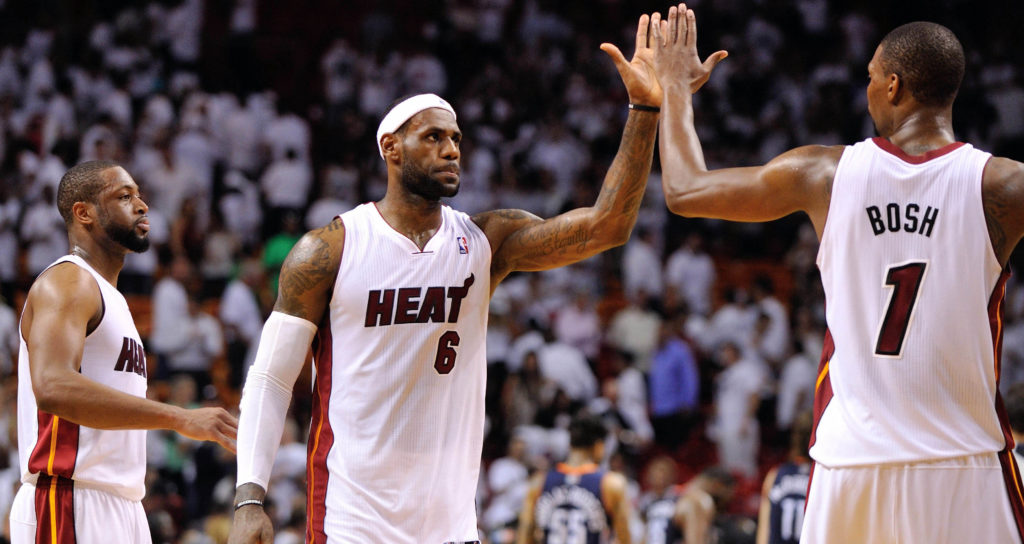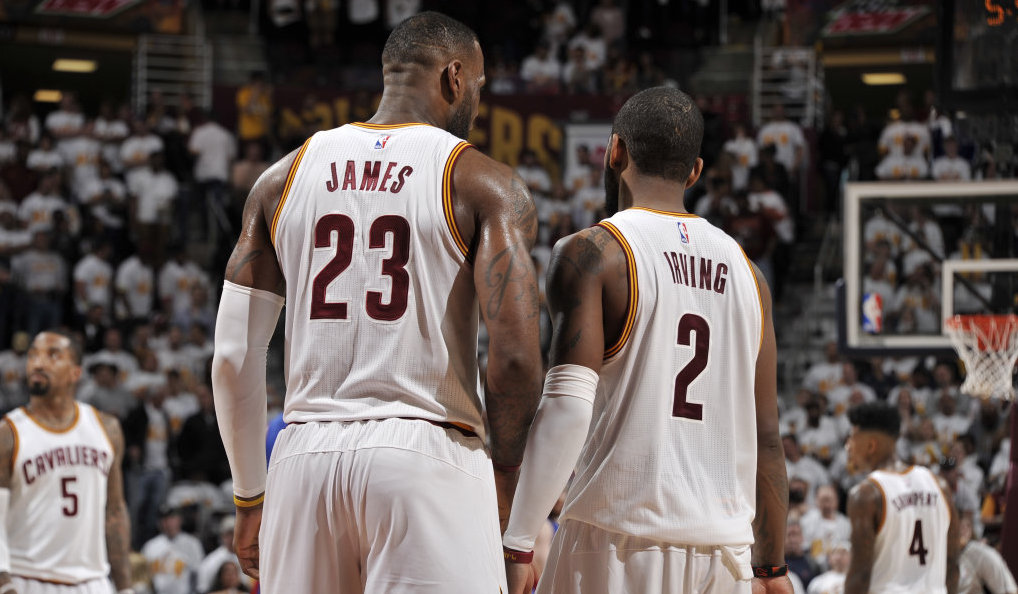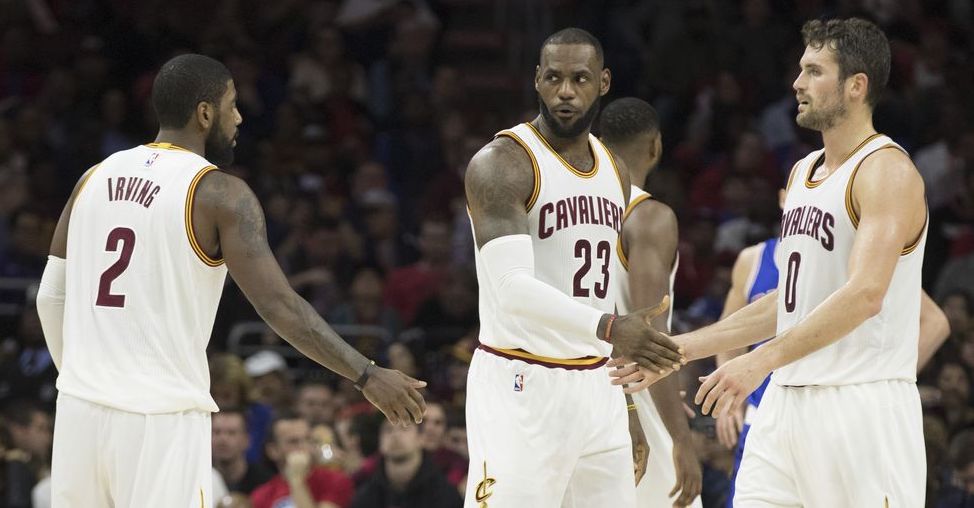It was not six months ago when Kevin Love for Amir Johnson, Jae Crowder, and a second rounder was considered not only a possibility but an even trade. Up until the trading deadline, numerous Love rumors were swirling. Similarly, the question of how LeBron James would perform post-prime danced through the minds of GM’s and fans alike.
With the benefit of hindsight, those trades look absolutely ridiculous now.
Cleveland is on a roll, with the NBA’s third highest offensive (111.2 ppg), placed comfortably ahead of any Eastern Conference competition, and readying themselves for a third-straight finals run — 7th straight for James. Cleveland is firing on all cylinders, and it’s can all be blamed not to an improved Kevin Love, or the underrated coaching of Tyronn Lue, but to the King himself, LeBron James.
James has changed his game, and with him changed the dynamic of the Big Three. Formerly employing the “take what we get mentality”, Cleveland has drastically shifted their game plan to a highly structured one. Cleveland still plays down to their opponents occasionally (see their 0-of-14 start against the Philadelphia 76ers for example), but James has molded this team into the beast David Griffin imagined when trading for Kevin Love in the first place.
Mahatma Gandhi once said, “If you change yourself, you will change your world.” While it can be safely assumed that the Indian social rights activist did not directly intend basketball for that quote’s application, it seems somewhat fitting as the most critical change James made to the Big Three was evolving his own game.
Before dissecting how James has changed his game, there are some terms that need to be clarified. One specific term is eloquently referred to as “A LeBron”. A LeBron refers to posting a stat line of 27-7-7 (Points-Assists-Rebounds). Originally a term coined by Reddit user “NYG_NYG”, the stat line refers to not only James’ average over the course of his career, but also his most commonly put up stat line. For reference including playoff games, James has put up 224 LeBron’s, through his career, his closest competitor is Michael Jordan at 123, with the third spot being taken by Russell Westbrook at 58. For the clarity of this article, the player LeBron James will be referred as “James” and the stat line a “LeBron”. From here, it can be examined how a LeBron has changed this year specifically.

Reuters
While James played for the Miami Heat, a noticeable part of his game changed, he averaged around two points less a game on around three fewer shots — a net positive in efficiency. The answer to this change is somewhat obvious, James was being asked to take less of the offensive load as Dwayne Wade and Chris Bosh (among others) provided top tier scoring teammates that he simply didn’t have during his first stint in Cleveland. While in his prime, James played physical, with most of his shots coming from the restricted area due to the driving nature of his game. However, towards the end of his Miami tenure, James started relying on his iconic midrange fade away, located somewhere between 12-18 feet from the basket. An iconic example of this exists in Game 4 of the second round of the 2015 NBA playoffs, where James sunk a fadeaway game-winner against the
However, towards the end of his Miami tenure, James started relying on his iconic midrange fade away, located somewhere between 12-18 feet from the basket. An iconic example of this exists in Game 4 of the second round of the 2015 NBA playoffs, where James sunk a fadeaway game-winner against the Chicago Bulls. This change in shot selection would be indicative of a greater change to James’ game over the next two years.
To look at the stats from 2015 and say James’ game had changed from that of 2010-2014 would be misleading. The ultimate goal of this iteration of Cleveland’s squad was to surround James with two skill players and role players. Kyrie Irving and Kevin Love were both primary examples of this.
A critical part of LeBron James’ game is his ability to draw a double-team. He mentions his assist ability and court vision constantly as a point of pride, . For this reason, one of the most successful compliments to James is a stretch four. His first stint in Cleveland is where the formula was proven successful, casting Donyell Marshall in a kick out option role. Bosh would be the primary example during his Miami days and Love’s shooting stroke and defensive presence on boards made him a primary candidate for the part. By late 2016, Kevin Love would easily prove to be the highlighted star in this role.
Kyrie Irving was Cleveland’s answer to Dwayne Wade. James expressed his intent to become more of a floor general and less of a scorer with his return in 2014-2015, meaning bulk scoring would be a priority. Irving saw a rise in his numbers during James’ first year, averaging two more points a game on about one less shot. A combination of his lethal three-point shooting percentages, a scorching .415 and his finesse around the basket provided LeBron with a perfect, yet unmoulded wingman.

David Liam Kyle l Getty Images
Flash forward to 2016-2017 and we’re seeing a very different game from James, but not one that was unpredicted. James boasted about his court vision for years, and promised a reduction of workload through a higher assist/point ratio, though it’s only coming to fruition now. No longer is he plagued with injured teammates, ball hogs or controversy that brought the gears on his vision to a grinding halt, now James has all the tools to fully employ his ability at the point.
James has changed himself into a utility player, whose goal is the entire stat sheet, not just the points. No longer does he average a LeBron, but instead facilitates a system. One of the first comments that came out in 2014 following an early season loss to the Utah Jazz, where Irving had 0 assists.
“He came up to me and was like, ‘One, you can never have another game with no assists,’ ” Irving said, describing James’ words. ” ‘You can damn near have just one, two, three, but you can’t have zero.’ And I was like, ‘All right, cool, it won’t happen again.’ And it hasn’t happened since that game.”
It still hasn’t happened since, but the comment about assists was merely the groundwork for the gameplay he wanted to create. Known as a “motion offense”, Cleveland runs a variant of the triangle. Developed by Gregg Popovich in the 90’s as a counter to Phil Jackson’s triangle, the set involves swinging the ball around the three-point line until the best shot is found. Often described as “passing up a great shot for a better one” the offense is a more commonly run set by veteran teams as it requires unselfishness when it comes to scoring, but more importantly versatility of players. Cleveland has built a group of individuals to fit this set.
James’ shift from notching LeBrons to becoming a utility player is clearly visible on a stat sheet. Not only is he averaging almost four more assists per game than with Miami or his early tenure, but he’s increased his rebounding percentages. Spending more time as a small-ball power forward has helped his rebounding numbers, but it’s the motion system in place that allows for his shift. Often it is either only James, or James and either Tristan Thompson, Channing Frye or Richard Jefferson in the restricted area following a shot attempt, leaving on the defensive end three individuals to push the pace offensively, or an offensive rebound leading to an immediate kick out. As a result, the pace-and-space offense required to run motion sets has been implemented. This time last year, Cleveland was 28th overall for the PACE metric (Possessions per game), currently, they’re tied for 10th.
A decrease in James’ usage is another interesting casualty of this pace-and-space system. An increase in Kyrie Irving’s scoring load has contributed to this. 2016’s NBA finals was a solid example of this in practice. While in the 2015 playoffs James was the leading scorer in 16 out of the 20 games played, He’d only do it nine times in 2016’s run. Similarly, James has seen a reduction of field goal attempts. Currently averaging 18.0 a game, he’s seeing the third lowest field goal attempts per game in his career, while shooting at an above average effective field goal percentage of .544. He’s also seen a limit to the number of minutes per game played, down to 36 per game as opposed to 38 during his Miami tenure.
This leads us to a large deal of math. In Miami, James averaged 0.71 shots a minute, around one shot for every minute and a half of court time, scoring around 0.477 points per minute, which rounded works out to be about a point every two minutes. Additionally, he would assist on 0.17 baskets per minute, working out to around an assist for every five minutes of play. Creating an efficiency calculation of points per minute by shots per minute, we can see that during his prime, James carried a true shooting efficiency per minute of 0.676.
To put these numbers in context, the league average in the 2015-2016 season will be used. The average player played around 16.12 minutes per game, attempting 0.524 shots per minute, less than James in Miami and putting up more points, 0.651 per minute. They averaged far fewer assists than James, just around one every ten minutes, though the average player’s true shooting efficiency per minute metric landed them around .801. This obviously doesn’t mean LeBron James was a below average player, on the contrary, it
This obviously doesn’t mean LeBron James was a below average player. On the contrary, it did mean he had an increased number of shots taken per game and was the clear focal point of the offense in Miami. James’ number in 2014-2015 and 2015-2016 were similar, with slight increases in the efficiency per minute, however this season, James has become staggeringly and unprecedentedly efficient.
Despite limiting the number of minutes played, James found himself taking far fewer shots, finding the basket around once every two minutes. Scoring on those attempts is not a problem. James is converting around 0.651 points per minute on the court, miles above the league average. His true shooting efficiency per minute is more than double that of his time at Miami, and a solid 0.500 points higher than the league average, while playing more than double the average time.
Where the motion offense truly comes into play, however, is in the assist category. James is turning out more than 2.5 times the league average in assists per minute. That paired with an assist-to-turnover ratio of 2.69 as opposed to his career average of 2.02 shows a dramatic increase in both the volume of assists he is doling out, but similarly the efficiency of his point forward play.
Together, the Big Three make up around 90 percent of the total usage (time with the ball in their hands) on the Cleveland squad, with James contributing an assist or a secondary assist (pass to the assistor) on an additional 7 percent of plays, making James either directly or indirectly responsible for almost every single play Cleveland runs.
This, however, is not necessarily a bad thing. James running the show almost all the time gives him unprecedented control over the plays run and the spacing, giving him the ability to find players in their preferred areas. James’ change to his game has allowed the Big Three to readjust their roles in the Cleveland system.
